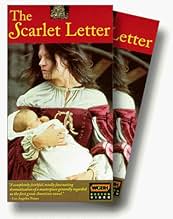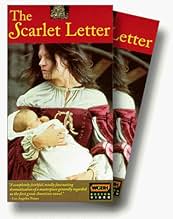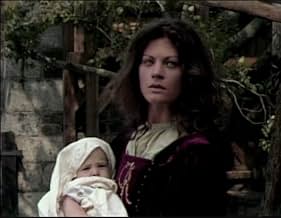In 17th century Massachusetts, a married woman (whose husband has been absent for years and his whereabouts unknown) has an affair resulting in a child out of wedlock. The puritanical reside... Read allIn 17th century Massachusetts, a married woman (whose husband has been absent for years and his whereabouts unknown) has an affair resulting in a child out of wedlock. The puritanical residents of her town condemn her to carry the Scarlet Letter of shame. Then the husband shows u... Read allIn 17th century Massachusetts, a married woman (whose husband has been absent for years and his whereabouts unknown) has an affair resulting in a child out of wedlock. The puritanical residents of her town condemn her to carry the Scarlet Letter of shame. Then the husband shows up.
- Won 1 Primetime Emmy
- 1 win total
Storyline
Did you know
- TriviaThe filmmakers' decision to outfit Hester Prynne with a gold letter "A" was sharply criticized at the time of the mini-series' premiere on P.B.S. as author Nathaniel Hawthorne was quite specific about the "scarlet letter" being red-colored. In the novel, the adjective "scarlet" wasn't only used in the symbolic sense (scarlet meaning "grossly and glaringly offensive" in the sense of "sinning in flagrant and scarlet fashion" [deriving from the use of the word in Isaiah 1:18 & Revelation 17:1-6], thus being associated with sexual immorality); the letter sewn onto Hester Prynne's clothing in the novel actually was colored scarlet, albeit it was sewn to her clothing with gold thread. In the words of Hawthorne, "...[W]ith all the townspeople assembled and levelling their stern regards at Hester Prynne, - yes, at herself, - who stood on the scaffold of the pillory, an infant on her arm, and the letter A, in scarlet, fantastically embroidered with gold thread, upon her bosom!" (Chapter Two).
- ConnectionsVersion of The Scarlet Letter (1908)
Now back to the actual story. As others have noted, this production looks as if it were done using home video. The film quality is spotty and uneven. Sound is also unbalanced. Many times when Meg (Hester) is speaking or mumbling, her words are blurred or unidentifiable. Other times, the sound is loud and harsh. The crowd scenes look as if people wearing dress-up clothes are walking awkwardly through a stage set - there is no _feel_ that they are Puritans of the 1640s. I never believed they believed in themselves - they looked like extras. Everyone seems to be walking everywhere - does anyone _do_ anything besides walk around 1640s Boston?
Meg Foster plays Hester Prynn, a young married woman who has lost her husband, and who has subsequently borne a child from an adulterous affair. She is silent about the father, and Puritan Boston disparages and condemns her. She is forced to wear a large "A" on her clothes; she embroiders and enhances this letter, and continues to live in town for the next seven years along with her child, Pearl, played by Elisa Erali. She rears Pearl alone in an isolated hut, but begins to win the hard hearts of the townspeople by her unselfish acts. Meg Foster plays Hester as if every emotion is battened down. In most scenes, Meg is stonefaced, speaking every line in the same tone. After three hours of this, it gets a bit monotonous. She does have some tears in the final scene, however.
John Heard plays Arthur Dimmesdale, the errant pastor. He is beloved by his flock, but he carries a secret shame that grows daily over seven years, causing him sickness and debility. John Heard, thin in this film, does an adequate job playing a man playing a pastor. He thunders at some moments from the pulpits, and at other times spouts proverbial wisdom and admonishment. Like Meg Foster, John plays Arthur in a flat manner. Even his loud cries seem to come from an automaton. At the end of the movie, John/Arthur confesses his act, bringing Hester and Pearl to the very scaffold where Hester was first condemned, and then dies. Of course the crowd is shocked - _shocked!_ - by his confession. And they go about their business.
Kevin Conway plays Roger Chillingworth, Hester's husband, who was rescued by Indians and taught the magic herbal lore of unspoiled savages. He comes to Boston to find his wife with a baby by an unnamed father, confronts Hester secretly, and somehow convinces her to keep quiet about his true identity. Kevin/Roger befriends John/Arthur, and in spite of his obvious wig and makeup convinces Arthur to let him treat Arthur's illness, which grows worse under his care. Arthur apparently thinks this is O.K., and he grows sicker and sicker. When Arthur finally dies, Roger disappears in the bulrushes, where we think he would have profitably and solitarily occupied himself much earlier in the film.
Much of the anguish of this story would have been moot had Hester (a) been a little less trusting of Arthur, (b) told Arthur that a _man_ would stand up for his woman, (c) told Roger to bugger off with his plans of secrecy, (d) moved away to another town or back to England, (e) expressed a bit more emotion. But the plot of this story required Hester to do stupid things throughout the movie/book.
Arthur, of course, is portrayed as the typical pious person who can't keep his zipper zipped, and yet needs to appear to be righteous. He is aggrieved by his actions in his adultery, but cannot confess his actions even as he berates others for their failings. Of course, no moral person has any ability to admit fault, so Arthur has to sicken and die, rather than come to a reasonable state of admitting his part in Hester's adultery. It takes two to tango, but Arthur never returns to the dancehall.
Roger's continual destructive actions against Arthur seem plain as day to the viewer/observer, but somehow every citizen of Boston is blind to his plans. These, of course, are people who've come to America to build a New World, who have a keen eye for reality, who have to eke out their living in a hostile, cold, and forbidding world - and yet they don't see the obvious evil nature of Roger. They are rubes taken in by a ruthless proto-Yankee.
The most disappointing thing about this story and production (and there are plenty of disappointments) is the general feeling of unreality in the acting, costumes, and sets. It looks like one big Hallowe'en party, with everyone very self-conscious about their costumes. Nothing looks like it's actually worn or used. While the production takes place in some genuine pioneer locations, it feels like a few carpenters got together to knock together some sets. Given that these Puritans came from England, and that they were skilled workers, it's hard to believe that the slipshod handiwork was real. Fences look "old-timey," as if Puritans couldn't really be bothered with getting railing upright, and yet their clothing is perfectly sewn as if by machine, and completely unwrinkled in all occasions, as if the Puritans also never really lived. It gives the feeling that the producers felt the Puritans were unreal or imaginary people who just walked through life. It does not give the feeling that these Puritans were hardworking and focused people who enjoyed their creation of and membership in a new society.
- TumnusFalls
- Jan 15, 2004
- Permalink
- How many seasons does The Scarlet Letter have?Powered by Alexa
Details
- Release date
- Country of origin
- Official site
- Language
- Also known as
- La letra escarlata
- Filming locations
- Production company
- See more company credits at IMDbPro
Contribute to this page




























